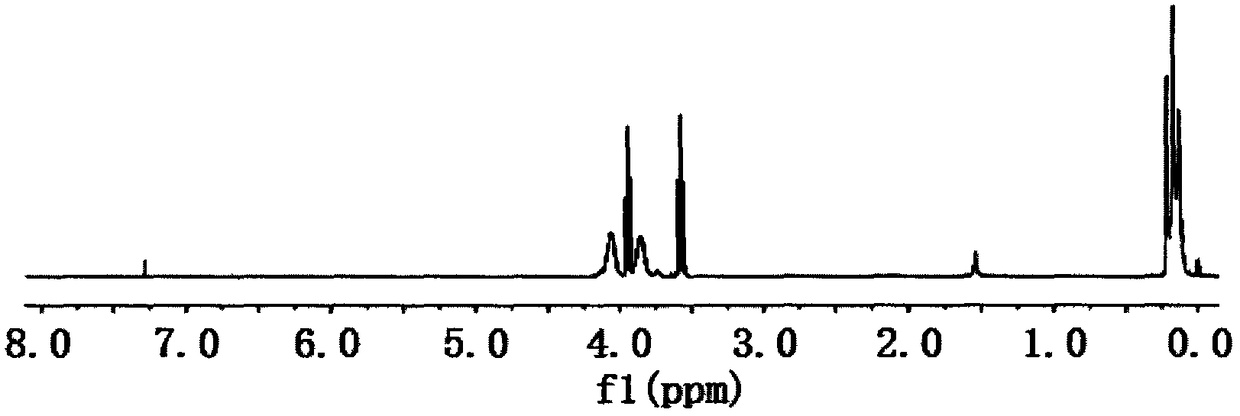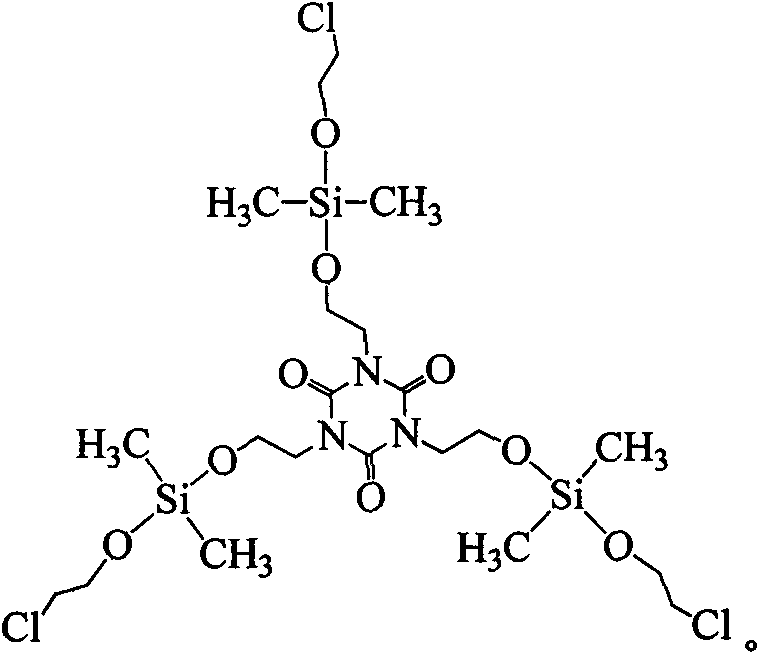Tris(2-dimethylchloroethoxysilyloxyethyl)isocyanurate compound and preparation method thereof
A technology of dimethylchloroethoxysilyloxyethyl and isocyanurate, which is applied in the field of flame retardant plasticizers, can solve problems such as application limitations, and achieves high molecular weight, good plasticization and compatibility good effect
- Summary
- Abstract
- Description
- Claims
- Application Information
AI Technical Summary
Problems solved by technology
Method used
Image
Examples
Embodiment 1
[0027] Embodiment 1 In the 250ml four-necked bottle that stirrer, thermometer and condensation tube are equipped with, and drying tube and hydrogen chloride absorption device are equipped with at the top of condensation tube, replace the air in the bottle with nitrogen, add 8.74g (0.0333mol ) Tris(2-hydroxyethyl)isocyanurate and 80ml dioxane, add 12.91g (0.1mol) dimethyldichlorosilane below 30°C, heat up to 60°C, keep warm for 8h; After completion, lower the temperature to below 5°C, replace the drying tube with a highly expandable sealing sleeve, and pass 4.41g (0.1mol) of ethylene oxide under the liquid surface, and control the reaction temperature not higher than 20°C at the rate of introduction. 2 hours after the completion of the passage, the temperature was raised to 60°C, and the reaction was kept for 4 hours; the solvent and a small amount of low boiling point were removed by distillation under reduced pressure to obtain tris(2-dimethylchloroethoxysilyloxyethyl)isocyanu...
Embodiment 2
[0028] Embodiment 2 In the 250ml four-necked bottle that stirrer, thermometer and condensation tube are equipped with, and drying tube and hydrogen chloride absorption device are equipped with on the top of condensation tube, replace the air in the bottle with nitrogen, add 8.74g (0.0333mol ) tris(2-hydroxyethyl)isocyanurate and 100ml tetrahydrofuran, add 12.91g (0.1mol) dimethyldichlorosilane below 30°C, heat up to 50°C, and keep warm for 9h; after the HCl is released, Lower the temperature to below 5°C, replace the drying tube with a highly expandable sealing sleeve, and inject 4.70g (0.1067mol) of ethylene oxide under the liquid surface, and control the reaction temperature at a rate not higher than 20°C. After 1h, the temperature was raised to 40°C, and the reaction was kept for 8h; the excess ethylene oxide was removed by distillation under normal pressure, and the solvent and a small amount of low boiling point were removed by distillation under reduced pressure to obtain...
Embodiment 3
[0029] Embodiment 3 In the 250ml four-necked bottle that stirrer, thermometer and condensation tube are housed, and drying tube and hydrogen chloride absorption device are equipped with at the top of condensation tube, replace the air in the bottle with nitrogen, add 8.74g (0.0333mol ) Tris(2-hydroxyethyl)isocyanurate and 120ml acetonitrile, add 12.91g (0.1mol) dimethyldichlorosilane below 30°C, raise the temperature to 65°C, and keep it warm for 7h; after the HCl is released, Lower the temperature to below 5°C, replace the drying tube with a highly expandable sealing sleeve, and inject 5.14g (0.1167mol) of ethylene oxide under the liquid surface, and control the reaction temperature at a rate not higher than 20°C. After 2 hours, the temperature was raised to 55°C, and the temperature was kept for 6 hours; the excess ethylene oxide was removed by distillation under normal pressure, and the solvent and a small amount of low boiling point were removed by distillation under reduce...
PUM
| Property | Measurement | Unit |
|---|---|---|
| decomposition temperature | aaaaa | aaaaa |
| density | aaaaa | aaaaa |
| refractive index | aaaaa | aaaaa |
Abstract
Description
Claims
Application Information
 Login to View More
Login to View More - R&D
- Intellectual Property
- Life Sciences
- Materials
- Tech Scout
- Unparalleled Data Quality
- Higher Quality Content
- 60% Fewer Hallucinations
Browse by: Latest US Patents, China's latest patents, Technical Efficacy Thesaurus, Application Domain, Technology Topic, Popular Technical Reports.
© 2025 PatSnap. All rights reserved.Legal|Privacy policy|Modern Slavery Act Transparency Statement|Sitemap|About US| Contact US: help@patsnap.com



